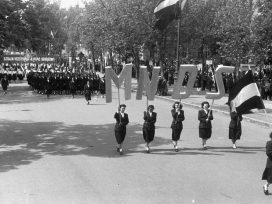In Hungary after 1993 the institution of minority self-government favoured the publication of national minority books; this article will discuss two books on the Armenian cult of the dead published within the Armenian diaspora in Hungary. To show the social context in which the books were published and throw light on its driving forces, we must briefly describe the Armenian minority in Hungary and its two main historical strata.
The first diaspora consists of the descendants and families of Armenian merchants, cattle breeders, who moved in large numbers in the eighteenth century from Armenian centres in Transylvania where the first big wave of migration had arrived in the seventeenth century, mainly through Moldavia. They are now assimilated into the Hungarian nation, they no longer speak Armenian but are still aware in some way of their Armenian origin: they call themselves Hungarian-Armenians, as do the descendants of the Armenian settlers who remained in Transylvania.
The second diaspora was the result of the genocide in Turkey in 1915-1917 and the historical events that led up to it: the refugees fleeing from the brutal measures of Sultan Abdul Hamid II and then of the Young Turks, and later the survivors of the genocide, were scattered around the world, with some settling in Hungary (and in Transylvania). They were joined later by families emigrating in the years 1988-91 who sought refuge in Hungary from the events in Armenia and the Caucasus – the war in Nagorno-Karabakh, civil wars in the Caucasus region, earthquake, the disintegration of the Soviet Union and economic decline. The members of the first stratum of the diaspora call this (more or less homogeneous) group of Armenians, Eastern Armenians. Even the second and third generation descendants of these families speak Armenian; they generally belong to the Armenian Apostolic Church and, even in Hungary, live the everyday life of Armenians within the family.
Under the provisions of the 1993 Act on Minorities in Hungary these two groups, belonging to very different historical diasporas, were united into a single Armenian minority. However, the nominal group formed this way never became homogeneous: essential differences, such as use or not of the Armenian language, membership of the Armenian Apostolic Church or the Armenian Catholic Church, or having been affected by the genocide draw the borderlines between the two strata; this was manifested in many cases by a conflict of interest between the groups.
Conflict of interests: Causes and effects
The Armenians settled in Transylvania in 1672 by Prince Mihaly Apafi I were treated by Hungarian law for a century as foreigners with special legal status; however, the distinction between the merchant elements and the estate owners became increasingly blurred. At first Armenians could not buy land and could not hold public office, but following their legal integration into Hungary in 1776 they acquired the right to hold public office and the same rights and obligations as Hungarians. They saw this as a victory and strove to be exemplary Hungarians; breaking with family traditions they tried to enter new occupations. With modernization in the early-nineteenth century they began to lose their language, the younger generation dispersed into the larger towns of Transylvania and Hungary, Armenians acquired nobility and landed estates and, by the 1840s, proudly proclaimed themselves to be Hungarian, even adopting Hungarian names. They wanted to be Hungarians – preserving traditions became less important than social preferment.
The loss of language resulting from integration and the neglect of traditions meant that the Hungarian-Armenians (like the Hungarian-Armenians of Transylvania) now regard themselves principally as Hungarians. Their Armenian identity comes to the fore only in certain situations; it depends on the environment and is relative. While their identity at the beginning of the twentieth century could still be described as plural (culturally Armenian, politically Hungarian), it can now be said to be more positional: the Armenian identity is brought to the surface by remembrance and is focused mainly on the major church feasts and commemoration linked to Armenian identity. In short, it depends on the situation.
Under the given conditions, the Eastern Armenian group settled in Hungary – the members of the second diaspora – reject the example of assimilation (experienced by them as something negative) with a defensive gesture and identify the group of Hungarian-Armenians as the host society rather than as an Armenian diaspora related to them in some way: after all, their experience of the original homeland is also different. Because the Hungarian-Armenians do not have an “Armenian world” that they could regard as unequivocal, or because this world is not unequivocally separate from the Hungarian world, the so-called Eastern Armenians increasingly openly reject them as part of the Armenian diaspora despite the nominal community that was created under the provisions of the Minorities Act: they are not prepared to accept any community or interaction with them. For these reasons it is also difficult to calculate the size of the Armenian community in Hungary: the two groups estimate the number of Armenians living in the country differently.
While the group of Eastern Armenians is increased from outside with new arrivals from Armenia and Karabakh, the Hungarian-Armenians of Hungary and Transylvania cannot expect any increase from outside, the group is striving to ensure this from inside, strengthening the Armenian awareness of potential members, even reaching across national borders. The Hungarian-Armenians of Hungary maintain more intensive relations with the Hungarian-Armenians of Transylvania than with any Armenians from Turkey, Armenia or even from Karabakh, Syria or Lebanon who may live in the same city, who arrived with the wave of settlers after the genocide and still speak Armenian.
The Hungarian-Armenians represent a special case of “transnationalism”: apart from the awareness of their common origin, what binds the community in Hungary and Transylvania is mainly mutual self-justification, their mythical-sentimental connection with the original little homeland, with Transylvania, while their connection to Armenia is largely only referential. This geographically extensive transnational community is far more homogeneous than the loose “group” described by the 1993 Act as the Armenian minority in Hungary.
The different directions of the reproduction of identity can also be clearly observed in the publication of books and periodicals by the two big historical strata of the Armenian diaspora in Hungary: while the group known as Eastern Armenians turns more towards the Armenian legends and the themes of Armenian history – placing special emphasis on the Armenian genocide of 1915-1917 – the group of Hungarian-Armenians understandably tends to focus more on Armenian aspects of the “original Armenian homeland in Transylvania”. After the adoption of the Minorities Act it became a pressing need for them to reformulate their Armenian identity: they wanted to explain the exceptional place the Armenian people occupies in Hungarian history and rationalize their loss of language. With each such act of remembrance the group of Hungarian-Armenians also commemorate their integration into Hungarian history.
Soul food: Armenian cemeteries in Transylvania

However, the purpose of this article is to discuss in more detail two books, two cemetery monographs. The genre may, perhaps, seem surprising at first sight, moreover, the two works may not fully meet the classification of monographs given their sometimes nostalgic-subjective tone. Nevertheless, their publication is a significant and useful achievement in the life of the Hungarian-Armenian group. For this reason, the publication of these books can also be interpreted both as an act of neo-Armenist aspirations and as a collective remembrance of the Armenian ancestors.
The first of these, edited by Dr. Sarolta Issekutz, is Örmeny halottkultusz es temetkezes. Erzsebetvaros es örmeny katolikus temetöje (Armenian Cult of the Dead and Burial. Erzsebetvaros and its Armenian Catholic Cemetery) and contains several studies and was published by the Transylvanian Armenian Roots Cultural Association in the series Transylvanian Armenian Museum in 2009. The book can best be classified as mixed genre: the first part is devoted to studies and the second can be defined rather as a town and cemetery monograph. The only exhaustive chronological forerunner to the book is a work on a similar theme: Attila Balazs-Becsi’s booklet A szamosujvari magyar-örmeny katolikus temetö monografiaja (Monograph of the Hungarian-Armenian Catholic Cemetery of Szamosujvar), published by the Armenian Minority Self-Government of Budapest’s 11th district in 2002 and edited by Gabor Szongoth. The former volume in part follows the methodology of the latter: it is its consequence and in a way also its continuation and development into a movement.
Neither work aims for completeness: they both mention in the introduction that they make no claim to scholarly purpose or to cover the whole of their subject; the aim in both cases is rather to mobilize, to attract attention, to turn towards the Armenian past by remembering ancestors, to call on and activate people to rescue material memories of Armenian cult places. Very probably this goal has been attained: a veritable cemetery rescue movement was launched during the preliminary work on the monographs, both in Szamosujvar and Erzsebetvaros, among others with the involvement of schoolchildren.

While the study by Attila Balazs-Becsi on Armenian burial in Szamosujvar is exclusively a cemetery monograph with a brief introduction on the history of the town and a series of art historical observations set out in a logical system, the volume on Erzsebetvaros covers a much wider spectrum, approaching the details of the cult of the dead in a broader context. Both monographs study with precision the material remains of Armenian burial places that can still be found today in Armenian cemeteries: they examine the graves as well as the gravestones and still legible inscriptions on the headstones for each cemetery section, also providing a map for ease of orientation. The monograph on the cemetery in Szamosujvar contains colour photographs of each grave and crypt tablet – the work lists not only the graves in the Armenian cemetery but also the crypts in the Armenian Catholic cathedral in the main square and the crypts in the Solomon church with their inscriptions. In contrast, the Erzsebetvaros cemetery monograph has colour photographs only of certain graves and gravestones: it records the Armenian Catholic graves of an historical monument nature and also gives the partly reconstructed inscriptions. However, the latter book also has a DVD with photos of all graves, the names of the persons buried and the grave inscriptions in a searchable format, irrespective of ethnic origin and denomination. This is because, due to mixed marriages, the purchase of burial plots and later burial on the same plot, there are also many Romanian Orthodox graves here (as there are in the Armenian cemetery in Szamosujvar). From the viewpoint of Armenian descendants, this “illustrated list” is the most pragmatic part of both books; it can be used to find the burial place of Armenian relatives who may have lived in Szamosujvar or Erzsebetvaros.
 However, as already mentioned, the first part of the monograph on Erzsebetvaros approaches the subject from a broader context that is worth examining. Before the monograph section, the book groups studies that explore the theme of the Armenian cult of the dead and burial from the original homeland in Armenia to the former homeland in Transylvania, from the beginnings to the rites of transition in the everyday life of Hungarian-Armenians. Thus, in accordance with the concentric editorial concept of approaching the theme of the cult of the dead, it is approached “from afar” in space and time – thinking of those who “fall outside the circle”, of those who presumably do not have any Armenian dead and perhaps do not know much about the Armenians either. For this reason, the approach to the theme includes an ethnological study on the Armenian cult of the dead and an essay on theology and church history. In her introductory study “Armenians”, the editor briefly sums up the stages in the history of the Armenian people, outlining the circumstances of their settlement in Transylvania. She covers the history of the Armenian diaspora in Hungary from the beginning to the present, the second diaspora of those who came after the genocide and the beginnings of a third Armenian diaspora, the arrival of the group who could be said to have come for economic reasons.
However, as already mentioned, the first part of the monograph on Erzsebetvaros approaches the subject from a broader context that is worth examining. Before the monograph section, the book groups studies that explore the theme of the Armenian cult of the dead and burial from the original homeland in Armenia to the former homeland in Transylvania, from the beginnings to the rites of transition in the everyday life of Hungarian-Armenians. Thus, in accordance with the concentric editorial concept of approaching the theme of the cult of the dead, it is approached “from afar” in space and time – thinking of those who “fall outside the circle”, of those who presumably do not have any Armenian dead and perhaps do not know much about the Armenians either. For this reason, the approach to the theme includes an ethnological study on the Armenian cult of the dead and an essay on theology and church history. In her introductory study “Armenians”, the editor briefly sums up the stages in the history of the Armenian people, outlining the circumstances of their settlement in Transylvania. She covers the history of the Armenian diaspora in Hungary from the beginning to the present, the second diaspora of those who came after the genocide and the beginnings of a third Armenian diaspora, the arrival of the group who could be said to have come for economic reasons.
In my opinion the ethnological study by Ditta Dukai titled “Az angyal megerkezett, s engem hiv. Lelekkepzet es halottbucsuztatas a XIX. szazadi örmeny közössegekben” (“The angel came and called me.” Concept of the soul and farewells to the dead in nineteenth-century Armenian communities) is the most professionally demanding piece, free of any nostalgic undertones and maintaining the required critical distance. Drawing on work done in scattered Armenian communities in Asia Minor in the late-nineteenth and early-twentieth centuries, the ethnologist presents the image of death held by those Armenian communities, their concept of the soul and burial customs, and the world-view and notions of the after-world that can be deduced from this. It is not possible in this short review to discuss the studies individually and according to their merits, but it is important to cite one sentence from this carefully precise writing as it faithfully reflects the background dynamics not only of the cult of the dead but also of the Hungarian-Armenian “cemetery movement” and can be said to support what I have already said here: “In the laments and the funeral songs the dead person appears as a member of the community: the portrayal of the character and the listing of the dead person’s actions in the laments reinforces their former position in the community and ensures that their memory will live on.” It is not simply that it is difficult for people in general and individually to come to terms with death: it can perhaps be said that a relatively small ethnic group is unwilling to accept any loss in its numbers; it wishes to see itself as eternal and powerful by prolonging the existence of its deceased members at the level of legend, at least perpetuating its numbers in this way, extending its own existence as a community – in short its history.
The Armenian cult of the dead has not yet been properly studied in contemporary social science and very few writings on the subject have come down to us from previous centuries. Among the source works mention must be made of the great nineteenth-century Armenologists Kristof Szongott and Lukacs Avedik, who made minutely detailed records of the customs of Transylvanian Armenians related to death and burial, thus preserving the customs once observed by Armenians in Transylvania. However, another article, written by Sarolta Issekutz and also new in content, Örmeny halottkultusz es temetkezes Bukovinaban es Erdelyben (The Armenian cult of the dead and burial in Bukovina and Transylvania) sums up the image of death and burial customs of the Transylvanian Armenians, drawing mainly on the work of Kristof Szongott (supported mainly by examples from Szamosujvar), Marton Tarisnyas and Katalin Gergely (illustrated with customs observed in the Armenian communities of Gyergyoszentmiklos). The author stresses the importance of the guilds in burial customs, the role of the Guild of Lads, the rite of the Red Capes (still practised) in the funeral ceremony and also gives an account of inheritance rights and customary law associated with death. The article by Attila Puskas Az örmeny halotti szertartas es teologia gyökerei (The Armenian funeral ceremony and its theological roots) should also be mentioned. It is a detailed study on the theological background and message of the funeral commemorations and ceremonies. On the basis of writings by Giuseppe Munarini, Professor of History from Padova, the author sums up, draws conclusions and also analyses the funeral customs, memorial days and burial rites. This is the only piece in the volume that approaches the theme of death from the sacred rather than the profane, human aspect.
The second half of the volume contains a condensed monograph on Erzsebetvaros and its Armenian cemetery, to which I have already referred in broad terms. It begins with the short monograph Erzsebetvaros by Issekutz: the cemetery monograph in this second part largely follows the structure of the monograph on the Szamosujvar cemetery by Balazs-Becsi, but in much greater detail. It discusses Erzsebetvaros and the burial customs of the Armenians who lived there, covering every detail of the Erzsebetvaros Armenian cemetery and taking stock of the former Armenian families, even giving their distribution by streets, the town’s local authority, its judges and mayors, its Armenian Catholic cathedral and Armenian cemetery.
It can be said that both volumes focus on the problem of territoriality, or more precisely of extra-territoriality. If we accept that the diaspora is the utopia of extra-territoriality, to this extent these two cemetery monographs can be seen as the symbolic materialization of the Hungarian-Armenian myth of return, which naturally can never go together with re-vindication of territory: in more poetic terms, as a “collective swan song”. The preparatory work for these volumes and the “cemetery movement” launched with their publication is a cultural gesture with which a group that is now seemingly entirely assimilated (that could be called ethnic only in the past) strives to maintain its continuity at the level of collective memory, evoking and reviving the distant past in this way. Books about death and burial do not make light reading, even for someone involved in Armenian history, but these books themselves are also soul food, reading and browsing through them the members of the community can reproduce the collective past again and again and with it also their own Armenian identity, remembering their departed Armenian ancestors and in this way keeping them alive, as well as the story of their Armenian identity.



 However, as already mentioned, the first part of the monograph on Erzsebetvaros approaches the subject from a broader context that is worth examining. Before the monograph section, the book groups studies that explore the theme of the Armenian cult of the dead and burial from the original homeland in Armenia to the former homeland in Transylvania, from the beginnings to the rites of transition in the everyday life of Hungarian-Armenians. Thus, in accordance with the concentric editorial concept of approaching the theme of the cult of the dead, it is approached “from afar” in space and time – thinking of those who “fall outside the circle”, of those who presumably do not have any Armenian dead and perhaps do not know much about the Armenians either. For this reason, the approach to the theme includes an ethnological study on the Armenian cult of the dead and an essay on theology and church history. In her introductory study “Armenians”, the editor briefly sums up the stages in the history of the Armenian people, outlining the circumstances of their settlement in Transylvania. She covers the history of the Armenian diaspora in Hungary from the beginning to the present, the second diaspora of those who came after the genocide and the beginnings of a third Armenian diaspora, the arrival of the group who could be said to have come for economic reasons.
However, as already mentioned, the first part of the monograph on Erzsebetvaros approaches the subject from a broader context that is worth examining. Before the monograph section, the book groups studies that explore the theme of the Armenian cult of the dead and burial from the original homeland in Armenia to the former homeland in Transylvania, from the beginnings to the rites of transition in the everyday life of Hungarian-Armenians. Thus, in accordance with the concentric editorial concept of approaching the theme of the cult of the dead, it is approached “from afar” in space and time – thinking of those who “fall outside the circle”, of those who presumably do not have any Armenian dead and perhaps do not know much about the Armenians either. For this reason, the approach to the theme includes an ethnological study on the Armenian cult of the dead and an essay on theology and church history. In her introductory study “Armenians”, the editor briefly sums up the stages in the history of the Armenian people, outlining the circumstances of their settlement in Transylvania. She covers the history of the Armenian diaspora in Hungary from the beginning to the present, the second diaspora of those who came after the genocide and the beginnings of a third Armenian diaspora, the arrival of the group who could be said to have come for economic reasons.




